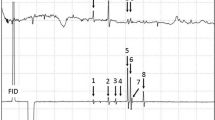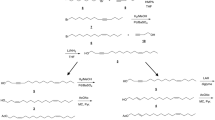Abstract
The relative efficacy of disruptant blends comprised of different combinations of the Oriental fruit moth's pheromone components was determined in field tests. Disruption was evaluated by comparing male moth catch at synthetic and female-baited traps in disruptant and non-treatment areas. Three atmospheric dosages of a 8-dodecenyl acetate (93.5%Z∶6.5%E) blend, representing two successive 10-fold decreases in concentration (2.5 × 10−2 g/hectare/day to 2.5 × 10−4 g/hectare/day) were tested alone and in combination with an additional percentage of (Z)-8-dodecen-1-ol. Male moth orientation to traps was eliminated in plots exposed to the two highest binary acetate dosages. However, significantly more males were captured in synthetic-baited traps in the lowest acetate-alone treatment, indicating a diminution of disruption efficiency. In contrast, inclusion of (Z)-8-dodecen-1-ol in the disruptant blend effected essentially complete disruption of orientation at all concentrations tested. Mating success ofG. molesta pairs confined in small cages apparently was not affected by the presence of relatively high concentrations of the binary acetate and the acetate-alcohol blends. This suggests that habituation and/or adaptation of male response, at least for comparatively “close-range” behaviors, did not occur.
Similar content being viewed by others
References
Baker, T.C., andCardé, R.T. 1979a. Courtship behavior of the Oriental fruit moth (Grapholitha molests): Experimental analysis and consideration of the role of sexual selection in the evolution of courtship pheromones in the Lepidoptera.Ann. Entomol. Soc. Am. 72:173–188.
Baker, T.C., andCardé, R.T. 1979b. Analysis of pheromone-mediated behaviors in maleGrapholitha molesta, the Oriental fruit moth (Lepidoptera: Tortricidae).Environ. Entomol. 8:956–968.
Cardé, A.M., Baker, T.C., andCardé, R.T. 1979. Identification of a four-component sex pheromone of the female Oriental fruit moth,Grapholitha molesta (Lepidoptera: Tortricidae).J. Chem. Ecol. 5:423–427.
Cardé, R.T. 1976. Utilization of pheromones in the population management of moth pests.Environ. Health Perspect. 14:133–144.
Cardé, R.T. 1981. Disruption of long-distance pheromone communication in the Oriental fruit moth: Camouflaging the natural aerial trails from females?in E.R. Mitchell (ed.). Management of Insect Pests with Semiochemicals: Concepts and Practice. Plenum Press, New York, (in press).
Cardé, R.T., Trammel, K., andRoelofs, W.L. 1975. Disruption of sex attraction of the redbanded leafroller (Argyrotaenia velutinana) with microencapsulated pheromone components.Environ. Entomol. 4:448–450.
Cardé, R.T., Baker, T.C., andCastrovillo, P.J. 1977. Disruption of sexual communication inLaspeyresia pomonella (codling moth),Grapholitha molesta (Oriental fruit moth) andG. prunivora (lesser appleworm) with hollow fiber attractant sources.Entomol. Exp. Appl. 22:280–288.
Gentry, C.R., Beroza, M., Blythe, J.L., andBierl, B.A. 1974. Efficacy trials with the pheromone of the Oriental fruit moth and data on the lesser appleworm.J. Econ. Entomol. 67:607–609.
Gentry, C.R., Beroza, M., Blythe, J.L., andBierl, B.A. 1975. Captures of the Oriental fruit moth, the pecan bud moth, and the lesser appleworm in Georgia field trials with isomeric blends of 8-dodecenyl acetate and air-permeation trials with the Oriental fruit moth pheromone.Environ. Entomol. 4:822–824.
Rothschild, G.H.L. 1975. Control of oriental fruit moth [Cydia molesta (Busck) (Lepidoptera, Tortricidae)] with synthetic female pheromone.Bull. Entomol. Res. 65:473–490.
Rothschild, G.H.L. 1979. A comparison of methods of dispensing synthetic sex pheromone for the control of oriental fruit moth,Cydia molesta (Busck) (Lepidoptera: Tortricidae), in Australia.Bull. Entomol. Res. 69:115–127.
Rothschild, G.H.L. 1981. Current status and prospects for mating disruption of insect pests,in E.R. Mitchell (ed.). Management of Insect Pests with Semiochemicals: Concepts and Practice. Plenum Press, New York (in press).
Sower, L., Turner, W., andFish, J. 1975. Population-density-dependent mating frequency amongPlodia interpunctella in the presence of synthetic sex pheromone with behavioral observations.J. Chem. Ecol. 1:335–342.
Author information
Authors and Affiliations
Additional information
Lepidoptera: Tortricidae.
Published as Journal Article No. 9569 of the Michigan Agricultural Experiment Station.
Rights and permissions
About this article
Cite this article
Charlton, R.E., Cardé, R.T. Comparing the effectiveness of sexual communication disruption in the oriental fruit moth (Grapholitha molesta) using different combinations and dosages of its pheromone blend. J Chem Ecol 7, 501–508 (1981). https://doi.org/10.1007/BF00987698
Received:
Revised:
Issue Date:
DOI: https://doi.org/10.1007/BF00987698




